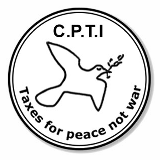Fundraising for CPTI and national Peace Tax Movements
Moderator: Marian Franz; Report: Jon Nott
We clarified our understanding or fundraising by identifying some different methods:
- individual donors/supporters/members
- state funding
- grant-making trusts/foundations
- collections e.g. churches
- merchandising
- event fundraising
- corporate donations/sponsorship
- legacies
experiences of fundraising
Any form of fundraising is ‘selling your product’ where the product is your cause, in this case CPTI and national movements. You need to know your ‘product’ and your audience in order to find a hook on which to hang any fundraising attempts.
At the core of all fundraising is a one-to-one relationship, which is very similar to lobbying -you are trying to convince someone to support your cause financially rather than politically.
Try to look at your project from the potential funder's point of view. e.g. Grant making trusts need applicants to disburse their funds to (they weren't set up to keep money in a bank account, they're meant to give it to good causes)- they need us as much as we need them!
Researching potential funders/donors in advance is a vital first step. Find out who they have given to before and how much they are prepared to give.
The product of your fundraising can become a fundraising tool. e.g. the US National Campaign for A Peace Tax Fund raised funds for a lobbying booklet “Congress shall make no law...”, which became a valuable fundraising tool as well as a lobbying tool.
It is far easier to fundraise if you/your board have all given yourselves. Some of the best fundraising is done by those committed to the issue or doing the work rather than a professional fundraiser.
A donor base is one of the most stable forms of income, but you need a constant inflow of new donors to counteract ‘natural wastage’. A donor base also has a cost as it cannot work without an up-to-date database and regular contact between the organisation and donors.
We discussed the issue of tax exemption on donations and talked about building a relationship with individual donors so as to personalise their giving experience. We talked about the benefits of ‘permission marketing’ and the different legal situations in different countries.
concentrating on CPTI
We looked at the eight types of fundraising identified earlier to see which were most suitable for CPTI.
- events - not feasible on an international level, but if national/local organisations want to organise fundraising events which benefit CPTI that would be a valuable contribution.
- collections - similarly CPTI cannot organise this on an international level, but national/local groups may want to encourage collections (e.g. in churches) to benefit CPTI.
- merchandising - CPTI doesn't have the resources (financial or otherwise) to produce merchandising and market it internationally.
- state funding - this was considered unlikely at present, but we should also consider intergovernmental bodies such as the UN or EU which sometimes fund work by NGOs.
- legacies - without a existing donor base we can only really appeal to past attendees of international conferences and/or members of national movements (see below).
- donor base - this raises issues of CPTI structure and infrastructure and the issue of potential conflict with national movements. We discussed the issue of CPTI infrastructure and agreed that without infrastructure CPTI will find it very difficult to fundraise and that CPTI infrastructure is a valid goal for a (small) portion of our fundraising. We discussed the relationship of CPTI to national movements, particularly whether individuals would support both their national movement and CPTI or whether they would choose between them. We also considered those individuals in countries without a national movement, but decided that this issue was much wider than just fundraising - it will have to be discussed by the board and may need to form a workshop topic at the next conference.
- grants - we considered the projects proposed by the board to see which might be priorities. We discussed the proposal for a CPTI leaflet in some detail, particularly at whom the leaflet would be aimed. We also discussed whether one leaflet could work for several audiences.
characteristics of the audience for a CPTI leaflet
- interest in human rights
- interest in the work of NGOs
- a focus on international activity
potential target audiences for a CPTI leaflet
- sympathetic individuals/groups working at the UN on peace/human rights issues
- people who haven't heard of the peace tax issue
- people who have heard of peace tax/war tax resistance in a national context, but haven't considered the international aspect
- funders
